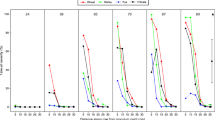Abstract
Populations of rhizosphere microflora of plants which have demonstrated an antagonism toward phytopathogenic nematodes, including velvet bean (Mucuna deeringiana), castor bean (Ricinus communis), sword bean (Cannavalia ensiformis), and Abruzzi rye (Secale cereale)., were compared to the rhizosphere microflora of soybean. Population densities of total bacteria were significantly lower for young Abruzzi rye, mature velvet bean, and mature castor bean, and fungi from mature velvet bean than for soybean. Population densities of spore-forming bacilli were significantly higher for Abruzzi rye than for soybean. Population densities of coryneform bacteria for mature sword bean and velvet bean were significantly higher than for soybean. All seedling test poants supported significantly higher population densities of chitinolytic fungi than soybean. On mature plants, chitinolytic bacteria were significantly higher on all test plants except velvet bean. Populations of endophytic root bacteria for three of the four test plants were significantly higher than for soybean. Fifty randomly, selected bacterial strains from seedlings and mature plants of soybean and each test plant were characterized for various physiological traits associated with rhizosphere competence, including chitinolytic activity, gelatin hydrolysis, production of hydrogen cyanide, starch hydrolysis, phenol oxidation, siderophore production, and production of antifungal compounds (inhibition ofPythium ultimum and/orRhizoctonia solani). There was a strong trend to increased frequency in each of the physiological tests with bacteria from test plants in comparison to those from soybean. The frequency of starch hydrolysis was up to 24 times greater for strains from test plants than for soybean strains, and siderophore production was up to 22 times more frequent for test plants. These results demonstrate that, compared to soybean, plants with properties antagonistic to phytopathogenic nematodes have a distinct rhizosphere microflora.
Similar content being viewed by others
References
Cook J R and Baker K F 1983 The Nature and Practice of Biological Control of Plant Pathogens. APS Press, St. Paul, MN. 539 p.
Curl E A and Truelove B 1986 The Rhizosphere. Springer-Verlag, New York. 288 p.
Grandados Alvarez N 1989 La rotación con leguminosas como alternativa para reducir el daño causado por fitopatógenos del suelo y elevar la producción del agrosistema maíz en el trópico húmedo. M.S. Thesis. Colegio de Postgraduados, Montecillo, México.
Gross D and Vidaver A 1978 A selective medium for isolation ofCorynebacterium nebraskense from soil and plant parts. Phytopathology 69, 82–87.
Johnson L F and Curl E A 1972 Methods for Research on the Ecology of Soil-borne Plant Pathogens. Burgess Pub. Co., Minneapolis, MN. 241 p.
Katznelson H 1946 The ‘rhizosphere effect’ of mangels on certain groups of soil microorganisms. Soil Sci. 62, 343–357.
Kloepper J W 1991 Plant growth-promoting rhizobacteria as biological control agents.In Soil Microbial Technologies. Ed. B Metting. Applications in Agriculture, Forestry and the Environment. Marcel Dekker, New York (In press).
Lear B 1959 Application of castor ponace and cropping of castor beans to soil to reduce nematode populations. Plant Dis. Rep. 43, 459–460.
Loper J E, Suslow T V and Schroth M N 1984 Lognormal distribution of bacterial subpopulations in the rhizosphere. Phytopathology 74, 1454–1460.
Mashkoor M, Siddiqui M A and Ahmad A 1990 Antagonistic plants.In Nematode Bio-Control: Aspects and Prospects. Eds. M S Jairajpuri, M Mashkoor Alam and I Ahmad. pp. 41–50. CBS Publishers and Distributors, New Delhi, India.
McInnis T, Klupfel D and Zehr E 1990 Suppression ofCriconemella xenoplax on peach by rhizosphere bacteria. Proc. 2nd Intern. Nematology Congr., Veldhoven, The Netherlands.
Millar R L and Higgins V J 1970 Association of cyanide with infection of birdsfoot trefoil byStemphylium loti. Phytopathology 60, 104–110.
Norris J R, Berkeley R C W, Logan N A and O’Donnell A G 1986 The genusBacillus andSporolactobacillus. (p. 1724)In The Prokaryotes Vol. II. Eds. M P Starr, H Stolp, H Trüper, A Balows, and A G Schlegel. pp 1711–1742. Springer-Verlag, Berlin.
Oostendorp M and Sikora R A 1989 Seed treatment with antagonistic rhizobacteria for the suppression ofHeterodera schachtii early root infection of sugar beet. Rev. Nématol. 12, 77–83.
Pedersen J F and Rodríguez-Kábana R 1991 Winter grass cover crop effects on nematodes and yields of double cropped soybean. Plant and Soil 131, 287–291.
Rich J R, Rahi G S, Opperman C H and Davis E L 1989 Influence of the castor bean (Ricinus communis) lectin (ricin) on motility ofMeliodogyne incognita. Nematropica 19, 99–103.
Rodríguez-Kábana R, Godoy G, Morgan-Jones G and Shelby R 1983 The determination of soil chitinase activity: Conditions for assay and ecological study. Plant and Soil 75, 95–106.
Rodríguez-Kábana, R, King P S, Robertson D G and Weaver C F 1988 Potential of crops uncommon to Alabama for management of root-knot and soybean cyst nematodes. Ann. Appl. Nematol. 2, 116–120.
Rodríguez-Kábana R, King P S and Weaver C F 1990 Potential of some tropical and subtropical legumes for the management of soybean (Glycine max) nematodes. (Abstr.) Nematropica, 20, 17.
Schaad N W 1988 Laboratory Guide for Identification of Plant Pathogenic Bacteria, 2nd Edition. APS Press, St. Paul, MN. p. 125.
Schwyn B and Neilands J B 1987 Universal chemical assay for the detection and determination of siderophores. Anal. Biochem. 160, 47–56.
Sikora R A 1988 Interrelationship between plant health promoting rhizobacteria, plant parasitic nematodes and soil microorganisms. Med. Fac. Landbouww., Rijksuniv. Gent 53, 867–878.
Vincente N E and Acosta N 1987 Effects ofMucuna deeringiana onMeloidogyne incognita. Nematropica 17, 99–102.
Weller D M 1988 Biological control of soilborne plant pathogens in the rhizosphere with bacteria. Annu. Rev. Phytopathol. 26, 379–407.
Author information
Authors and Affiliations
Rights and permissions
About this article
Cite this article
Kloepper, J.W., Rodríguez-Kábana, R., McInroy, J.A. et al. Analysis of populations and physiological characterization of microorganisms in rhizospheres of plants with antagonistic properties to phytopathogenic nematodes. Plant Soil 136, 95–102 (1991). https://doi.org/10.1007/BF02465224
Received:
Revised:
Issue Date:
DOI: https://doi.org/10.1007/BF02465224




